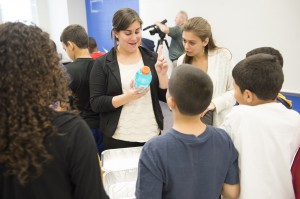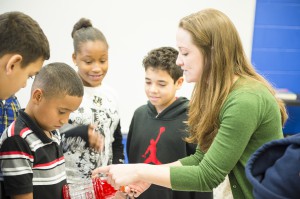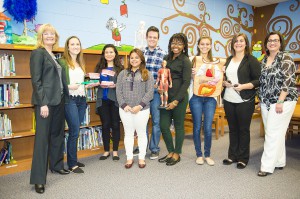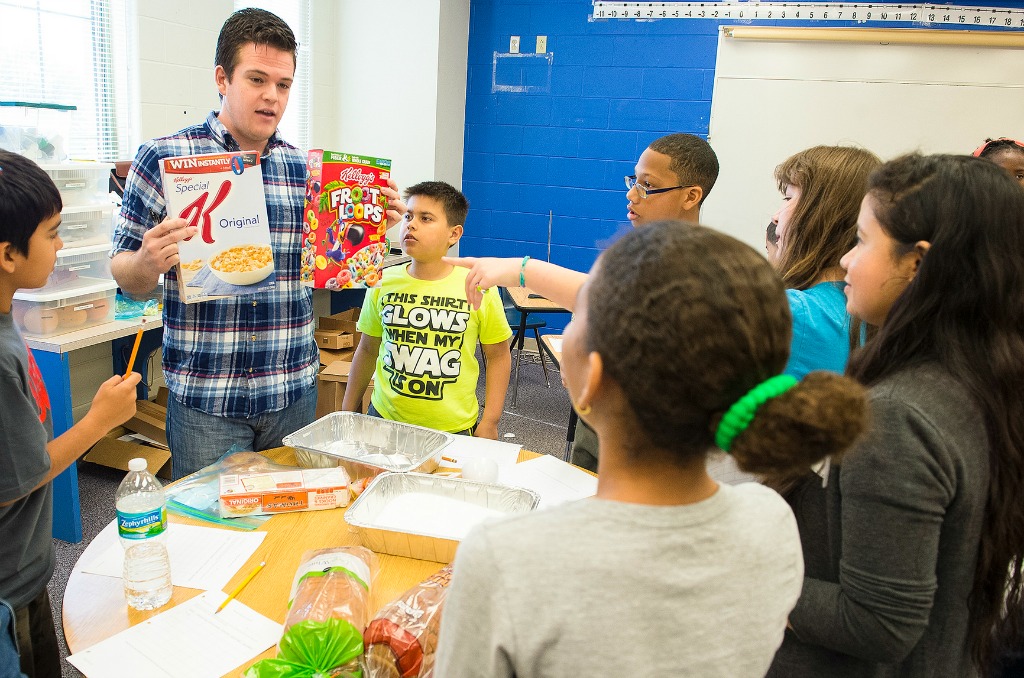In a classroom-turned-laboratory at Lawton Chiles Elementary School, a team of fifth-graders is carefully studying the nutrition label on a box of Froot Loops, checking out the amount of sugar, calories and nutrients in a serving size. They compare it to a box of Special K.
Meanwhile, another team of students are holding up 8-ounce cans of Pepsi, a 6.75-ounce box of Hi-C and a 32-ounce bottle of Gatorade. The tiny juice-box sized portion of Hi-C has 90 calories and 25 grams of sugar. The 12-ounce can of Pepsi has 150 calories and 41 grams of sugar. Meanwhile, the 32-ounce bottle of Gatorade has 200 calories and 56 grams of sugar.
Working in groups, they read the ingredient labels – and then carefully measure the amount of sugar contained in the drink, pouring it into a large pan.
The students were in for a shock, particularly when they got to the big jug of orange juice – and discovered that each serving contained 210 calories and 42 grams of sugar.
“I think they were surprised at how much sugar was in the drinks,” said Rachel Bell, a Valencia College nursing student. “I don’t think they realized how much sugar was in orange juice.”
This unusual nutrition lesson is part of Valencia College’s Health Academy, a six-week pilot program designed to teach elementary school students about nutrition and anatomy – and the impact that poor choices, whether that’s smoking or eating junk food or failing to exercise, can have on your body.
The Health Academy was the brainchild of Valencia College biology professor Olga Vazquez, who teaches the fifth-grade students the science behind each week’s lesson. After an introductory lesson, a team of eight Valencia College students work with the fifth-graders to help them with hands-on experiments that reinforce the day’s lesson.

Bell signed up to help teach the fifth-graders about biology and nutrition because she’s passionate about teaching people about their health.
“What I get out of it is seeing them make connections – about what we’ve been teaching them — and having that ‘aha’ moment,” said Bell.
Those “aha” moments are adding up quickly for the students at Lawton Chiles. Eleven-year-old Romeo Cruz went home after a recent lesson and told his mother all the things he was learning – including the proper way to brush your teeth. One of the first lessons included a hands-on session, in which the fifth-graders practicing by using large toothbrushes on giant models of teeth.
“I told my mom about it and she thought it was cool,” said Romeo. “You’re supposed to brush your teeth slowly, going in circles, not up and down.”
And that’s the idea behind the Health Academy program – that the elementary school students will carry those healthy messages back to their families. “When they get home, we want them to choose foods that are healthier – and help mom pick out healthier foods at the supermarket,” says Valencia College professor Olga Vazquez.
Vazquez came up with the idea for the Health Academy after attending a conference at which Brigham Young University professor Jonathan Wisco discussed a community outreach known as the Anatomy Academy, which he created while working at the University of California, Los Angeles.
Inspired, the Valencia biology professor decided to try a similar program at Lawton Chiles Elementary School in east Orange County. The school, which was adopted by Valencia College’s East Campus last year, has a diverse student body and almost 70 percent of the students are eligible for free lunches. In low-income communities, diabetes and other preventable diseases remain significant health challenges – and teaching children to adopt good habits may pay off in the long run, says Vazquez.
So, for six weeks, Vazquez and eight Valencia College students – most of them pre-nursing or pre-med students – are volunteering to spend 90 minutes each Friday afternoon, teaching a classroom full of squirming fifth-graders about anatomy and how it relates to their health.
“I’m a nursing major and I really like working with kids, so this was a natural way for me to earn volunteer hours and make a difference,” said Valencia student John Hebert. Hebert, who has worked as a camp counselor and church youth group leader, finds his experience with kids pays off in the classroom. “I used to be a clown and a balloon artist, so you learn how to handle kids,” he says, laughing.
Serving as a mentor for a half-dozen fifth-graders, Hebert and his partner guide the students through the day’s experiment – helping them decipher the nutrition labels, measure the salt and sugar in each product, and discuss the best choices.

“I learned how to understand the nutrition label on a package today,” said 11-year-old Antonio Jackson. As for the best beverage in the experiment? “That’s easy,” he said. “It was water.”
Funded by a $10,000 grant from the Osteopathic Foundation of East Orlando (an affiliate of Florida Hospital), the Health Academy program also encourages students to exercise – and has provided each child with a jump rope, which they practice using at school. In addition, the students have received food journals and are asked to write down everything they eat during the six-week program. Vazquez has also used the money to buy stethoscopes, blood pressure cuffs, notebooks and materials for the many hands-on experiments the children participate in.
The money also helped pay for anatomy models – including Mr. Bones, the skeleton, and Muscle Man, which shows the body’s muscles. Even more fun may be the vest with detachable internal organs – so students can learn where organs such as the liver, pancreas and heart are located.
In addition to anatomy, Vazquez’s team focuses on exercise, teaching students that jumping rope is a whole body exercise that can be done anywhere. And soon, the students will each receive a pedometer – and learn how many steps they need to take each day to stay fit.
For the fifth-grade students, the hands-on lessons are a welcome break from their usual fare. “These kids – who aren’t excited about school – love this and look forward to it,” says Nicole Gaumond, the students’ fifth-grade teacher. “They love it and they love working with the young mentors. They ask me every day: Is ‘Valencia science’ coming?”
Gaumond, who is in her 11th year of teaching, says the students who participate in the Health Academy seem more likely to remember what they’ve learned from these sessions, rather than standard science lessons. She’s hoping the program can be expanded so that all the fifth-grade students at Lawton Chiles Elementary will be able to participate.
The six-week program is a pilot, but Vazquez said her goal is to get enough funding to expand the program and teach all of the school’s fifth-graders, starting next fall.
“We hope at the end the kids will enjoy being healthy, and to change their lifestyle and their families,” said Vazquez. “And, hopefully, this is a way to inspire fifth-grade students to consider STEM careers and, ultimately, love science.”


Comments are closed.